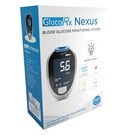Medical Emergencies in the Dental Practice
Glucometers, a standard clinical item or just a nice to have?
Introduction
When selecting a career pathway, it appears at times that we all must deviate from what is perceived as “our job role”. Myself for instance, I’ve found on many occasions offering non-specialist advice or assistance on topics and procedures ranging from emergency canine and feline life support to furniture removal! It came alongside my career in emergency care, I didn’t sign up for it, but had to accept it in order to get the job done.
Medical Emergencies in the Dental Practice
There are elements in all careers I suppose, in which one must deviate from the normal task from time to time. Some of these deviations are listed within professional standards such as managing medical emergencies, but others are often subject to one’s own interpretation.
Can standards be open for interpretation? I would hope not! However, in some instances they are, “Deep breath in”. Most of you reading this article would have undertaken annual training in managing medical emergencies in the dental practice. As with all training, the moment the session is completed you are responsible for keeping your clinical practice up to date in accordance with standards and guidance on managing medical emergencies in the dental practice.
The BNF is a reference for not only drugs, but also a rather specific set of standards relating to medical emergencies in the dental practice. The appropriately named section can be located alongside prescribing in the dental practice. Therefore, should be familiar to most prescribing dental professionals.
On first viewing this section, you will note that it lists the emergency drugs and their presentations that should be onsite at ALL dental practices. The section goes on to list and give an overview of the management of a number of common medical emergencies, in which a number of clinical devices or evaluations will be mentioned within the relevant management information.

Open for interpretation?
As an example of a standard being possibly open for interpretation I’m going to highlight a particular sentence within the management of “Hypoglycaemia“, taken from our source reference, medical emergencies in the dental practice within the BNF.
“Any patient with a blood-glucose concentration less than 4 mmol/litre, with or without symptoms, and who is conscious and able to swallow, should be treated with a fast-acting carbohydrate by mouth.”
Therefore, should a Glucometer be considered a standard item of clinical equipment that should be onsite within a dental practice? It doesn’t directly say it should be, but everyone’s interpretation and understanding of the above statement may differ. Do you have a glucometer onsite?
When offering guidance to dental practices, I would always suggest that glucometers are available for use. The value of the information that such devices offer, can lead to definitive diagnosis of apparent hypoglycemia, a blood sugar <4mmol/ L. Without the device, one could misinterpret the presented signs and symptoms as a cerebral vascular event (CVE) namely a Stroke / TIA.
Glucometer usage in patient assessment
70% of any diagnoses can be identified by taking a thorough medical history, followed up with appropriate tests, this will help lead to a diagnosis and ultimately a treatment plan. To highlight the benefits of having a glucometer we can review the following basic case studies.
Case Study 1
A 65-year-old female attended for a routine examination with a previous history of hypertension.
When booking in at reception the patient was questioned in relation to her last oral intake and medication use. The patient had a lighter than usual breakfast. It is noted that she has missed the last two appointments in the last 3 weeks for what she describes as “persistent winter viral infections”.
The patient has become unwell in the chair during the examination.
Noted signs and symptoms:
- Feels like she has a virus still but didn’t want to miss this appointment
- Normal to pale complexion
- Frequent sighing and describes mild shortness of breath on exertion
- Agitated and anxious
- Malaise
- Fatigue
- Nausea
- Polyuria
- Pungent halitosis
Following a basic assessment, it is rather easy to agree with the patient’s assumption that most of the signs and symptoms can be attributed to a viral infection. You may decide to suggest a GP visit if the symptoms persist. You also may decide to offer a glucose supplement as she did have a lighter than normal breakfast.
Let’s now reconsider the above and use a glucometer. You might be thinking at this moment, testing glucose, but there is no history of diabetes! That’s exactly the point!
The above signs and symptoms are classic signs of the onset of diabetes and/or diabetic ketoacidosis. A blood glucose reading is obtained, and the device displays a glucose level of 28mmol/L. It would be best practice to refer the patient to their GP immediately, with a referral letter for further assessment.

Case Study 2
A 67-year-old male attended for a routine examination, with a history of Type I diabetes, hypertension and 2 previous strokes. It is noted his facial muscle tone is relaxed on the right side and monoplegia with his right arm.
When attending reception, the patient was questioned in relation to their last oral intake and medication use. A lighter than usual breakfast and normal dose of medications with an intention to increase oral intake following the morning dental appointment.
The patient had been taken unwell in the reception area.
Noted signs and symptoms:
- Existing facial muscle tone and right arm monoplegia
- Pallor
- Slurred speech
- Difficulty in communicating
- Agitation
- Confusion
- Unsteady gait
Following a basic examination, your initial diagnosis may be a Stroke. The relative in attendance with the patient agrees and is very worried as this is reminiscent of a previous TIA and is uncertain if the existing facial muscle tone loss appears to be worsening. A 999 call is made, and you place the patient on oxygen due to the pallor and confusion. Care is continued until ambulance arrival.
Calling 999 for the above case is certainly advisable / essential. However, it may also be pertinent to consider the diabetes and the relevant history. It was noted that the patient took a lighter than normal breakfast, along with a normal dose of medications, with an intention to increase oral intake following their dental appointment.
Once again let’s consider the facts, the patient has taken their normal dose of insulin, but omitted the correct oral intake of food for the dose of insulin, therefore has an increased risk of Hypoglycaemia. (Potential insulin overdose, given the oral intake).
The use of a glucometer is essential to differentiate a stroke from hypoglycemia in this scenario. If on assessment blood sugar was 3.2mmol/l, the above scenario is clearly hypoglycaemia and therefore can be treated accordingly as per BNF guidance and protocols. However, if the blood glucose value was 6.8mmol/l then consideration must be given to a cerebral vascular event occurrence and appropriate emergency care sought.
Conclusion
Accurate physiological examination with diagnostics will often precede an accurate diagnosis. Accurate diagnoses of any medical emergency within a dental practice can at times be difficult to achieve. The lack of diagnostic medical equipment being the key factor. Once a medical emergency happens onsite, it is the responsibility of the dental team to manage the situation, conduct a basic examination, diagnose and commence treatment in accordance with current standards. Careful consideration must be made to ensure that the patient is placed onto the correct care pathway.
Often a call to the emergency services is the only option to ensure a full clinical assessment. You can see from the case studies above, that a simple device such as a glucometer is an essential tool to diagnose and treat a patient. Without it, we would be assuming diagnosis based only on conversation and history.
DD's Lead Resuscitation Officer Craig Nelson

DD offer a wide range of CPD training sessions including Medical Emergencies in the Dental Practice: Training Courses - Dental Business Support - DD (ddgroup.com)




